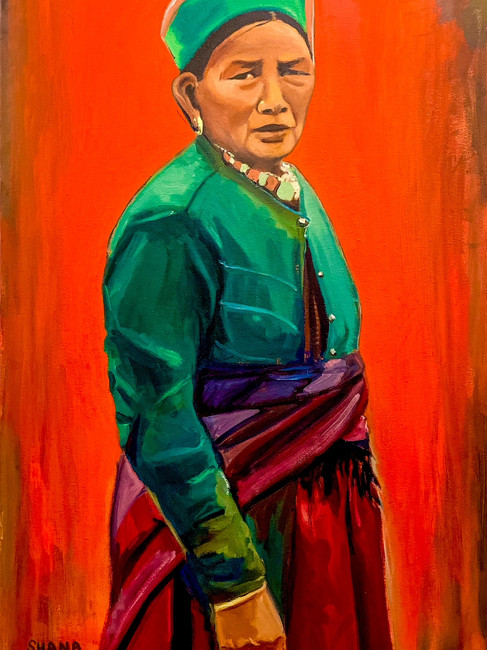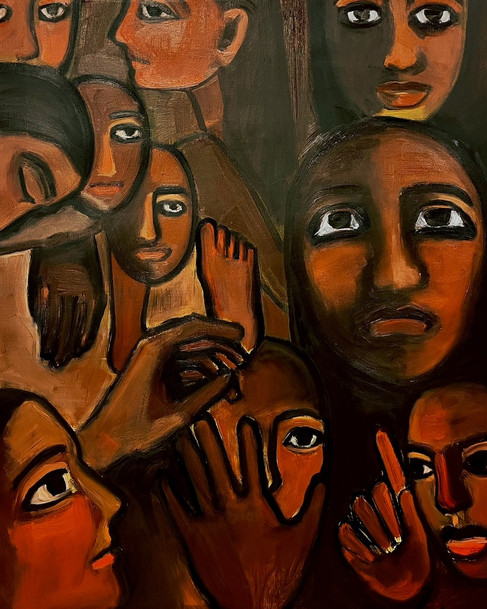Red is the Colour of Love
- Georgina Maddox
- May 2, 2024
- 8 min read
An interview of artist Shana Sood by Georgina Maddox

Artist Shana Sood brings to her work the complexity of the Indian woman that embodies strength, beauty, and fortitude. Her perspective originates from her experience of living as an Indian diaspora in the US; hence it is weaved with a sense of yearning where Indians living outside their motherland have evolved over the years to explore the strength of their artistic ecologies. Her works have been showcased at esteemed galleries and art centres across New England, including Arlington, Marblehead, and Plymouth. She also served as an anchor artist at the Patriot Place Art Gallery in Foxboro for four years until its closure in 2024.
GM: Tell us a little about your beginnings.
SS: Growing up in New Delhi, India, and being a Himachali, I had a constant dose of inspiration from both landscapes. Delhi, undoubtedly, is a kaleidoscope of rich scents, colours, textures, and stories to choose from at every corner and Himachal, through its serenity and majestic beauty, provides a meditative pedestal to reflect on your experiences.
I could not pursue art as a career due to family circumstances that deemed it necessary that I follow a conventional path that guarantees financial security for me and my family and therefore I am deeply grateful for Delhi to provide ample opportunity to pursue a self-motivated artistic discovery and evolution. One of my formative memories is when I would visit bookstores and used-book bazaars (especially the one in Daryaganj where booksellers would set up the books on the sidewalks) to read artist biographies. That is where I came across artists who resonated with me stylistically, artists like Amrita Sher-Gil, Gauguin, and Henri Matisse who used rich hues in their works. I am also thankful for my 5th grade art teacher who taught us how to manifest a portrait on a piece of paper - that is where I began my portraiture journey in earnest.
GM: Tell us about your artistic experience and more recently living in the US as an artist.
SS: While I've always had a passion for art, it wasn't until recently that I began to take it more seriously. A friend's challenge to showcase my work encouraged me to delve deeper into my craft, pushing me to explore new techniques, themes and ways of self-expression.
As an Indian artist residing in Massachusetts, I am grateful for the vibrant mosaic of art and culture that surrounds me, as well as the open-mindedness towards diverse artistic styles. This environment has been instrumental in nurturing my unique artistic expression without constraining it within any predetermined boundaries. Over the years, I've had the privilege of showcasing my work at esteemed galleries and art centers across New England, including Arlington, Marblehead, and Plymouth. However, the most fulfilling experience was serving as an anchor artist at the Patriot Place Art Gallery in Foxboro for four years until its closure in 2024. Immersed in a community of fellow artists and surrounded by inspiring creations, I've had the opportunity to learn from some exceptional talents along the way. While I've gleaned valuable insights from these encounters, I've always strived to infuse my own distinct style into my artwork. I️ seek to continue to evolve my artistic expression and venture beyond my current capabilities and point of view.
GM: Tell us what being a Diaspora artist means to you?
SS: Diaspora artists often connect with the world inside their heads, which is not necessarily reflective of the times or current reality. I feel like my canvases represent a romanticized version of an Indian-ness that belongs only in my mind. My hope is that my art traverses the duality of the heritage I left behind and what it has morphed into as I watch it evolve from the outside; in addition to doing justice to the co-existence of my past memories from homeland alongside with my current reality that breathes in a foreign land. It's about expressing the complexities of the various milestones of my cultural identity that have taken shape in diametrically opposite cultures and geographies.
GM: So, in a sense your work reflects the India you left behind which was not yet as globalized . . .
SS: Yes, even though I grew up in New Delhi myself, a city which can probably boast the widest rural to urban spectrum and a plethora of cultural sensibilities - very conservative to ultra-modern, watched English movies as a teenager; something about leaving your country and settling abroad, makes you cling on to the unadulterated parts of your heritage even more than if you had stayed on and grown within. I try to preserve this slice of time from the past as it keeps alive the cultural markers that are specific to India. Whether it is the image of an older woman sitting on a charpoy smoking a hookah, or of a little girl dressed in the traditional pavada blouse (skirt and blouse worn in Southern India) with a metal pot balanced on her head, the images recall a flavour of timelessness.
GM: Your portraits mainly represent traditionally dressed women, bedecked in jewellery and surrounded by foliage in dream-like settings. Tell us more about that.
SS: Yes, so far most of my paintings revolve around Indian womanhood, as this subject comes closest to my own lived experiences and in a sense is the truest passage to my identity. The women in my paintings serve both as muses and storytellers. As I reflect on some of the feedback from the viewers of my artwork, I realize that regardless of the various avatars my women subjects may take, they always appear self-sufficient and enough by themselves. My subjects are also silent carriers of my own biases and struggles with growing up a woman in India and help me challenge stereotypes and invite viewers to confront the complexities of gender dynamics within Indian society. As for why they are typically wearing sarees and such, by depicting women in traditional Indian attire, I seek to capture the cultural legacy that these garments embody while challenging the stereotypes and celebrating the diversity of women's experiences. While adorning traditional clothing, the women themselves can exude independence, modernity, and individuality, demonstrating that seemingly conservative tradition and contemporary identity can coexist harmoniously.
GM: Since you focus much on the female perspective, what role do men play in your work?
SS: Men do find their space in my work – they smile beguilingly, almost coy in a way under the gaze of the woman painter. Wearing his Himachali hat (called a kullu topi) or the turban typical of the Gujjars, my male subjects are interestingly less 'fierce' than the women I paint. Rather, they appear gentle and thoughtful, and this is perhaps my inner feminist speaking through all those years of conditioning, where women are coy and do not meet the gaze of the viewer. My portraits of women look the viewer right in the eye, conveying their melancholy or joy.
GM: You have done a lot of study of the 'Indian woman'. How do you question this trope?
SS: I seek to showcase the diversity of Indian women's experiences, highlighting their strength, resilience, and unique stories. With every portrait, I seek to present a nuanced perspective and invite a dialogue on their lives, ambitions, challenges which can manifest differently for each subject depending on intersections of gender, culture, class, and time.
I particularly like capturing close studies of Indian women surrounded by leaves and swatches of red, yellow, and brown. My portraits strive to depict who they are in their entirety, while muting their backgrounds to mere hues or foliage so the subjects themselves are the focal points. Through my portraits of Indian women, I want to offer viewers a glimpse into my personal journey and the diverse range of emotions experienced by my subjects, each with their own unique persona and story to tell. When it comes to the colour palette, I'm drawn to earthy tones such as browns, ochre, indigenous reds, yellows, oranges, and greens. These hues resonate with me instinctively, offering a sense of belonging and a canvas for my subjects to inhabit and share their narratives authentically.
GM: Tell us especially about red which features quite a bit in your work.
SS: The deep red in my paintings has been an organic favorite of mine, showing up in several of my works from recent years. It serves as a powerful conduit between my reality and nostalgic imagination. As a diasporic artist, the hue evokes a deep connection to my homeland, portraying not just passion and fury but also a complex web of memories and cultural associations.
For Indians, the colour red ignites a divine spark. This rich colour is often associated with Indian weddings. Traditional Hindu brides still wear red on their wedding day. Red is also the colour of the base chakra, it is called the mooladhara, which links us to Mother Earth and also to our survival instincts. The feminine power or Shakti, the Divine Goddess Herself, is associated with red. Red is the colour of the fearsome Goddess Kali's tongue. It denotes anger, power, passion, blood, and feminine mysticism. Quite contradictorily, it also stands for love, and this may be explained by looking at love as the other side of anger; it is as passionate, if not more so, especially maternal love.
GM: Your portrayal of your subjects exudes a palpable juxtaposition of fierceness and nurturing, embodying facets of your own identity while transcending individuality to represent the collective spirit of Indian womanhood. Tell us about this.
SS: In multiple cultures, including Indian culture, women often navigate a multitude of tasks and responsibilities, seamlessly transitioning between strength and tenderness in their daily lives. This juxtaposition is not a contradiction but rather a tribute to the complexity and richness of womanhood. It is this power that I plug into when I make my work and I hope it is conveyed through my lines, colours, and format. It is the combination of both the long-established and the modern that I bring to my work. Because as a woman I inhabit a space that is filled with elements of both and while one naturally looks for life that is progressive one also seeks to cling to time-honoured rituals (at least the ones that are fair and equitable). There is a certain sense of belonging that is ingrained into 'Diaspora', and it is this aspect and element that I think reflects in my work.

GM: We are looking forward to your upcoming solo in 2024-2025. Tell us about it.
SS: Yes, I aim to showcase fresh creations alongside my previous works. This upcoming solo exhibition in India marks a significant milestone for me. My goal is to put together an exhibition that resonates with the diasporic experience. For many within the Indian diaspora, there is a constant struggle around identity and belonging leading to feeling estranged from both their country of origin and their adopted home. Through my art, I aspire to bridge this gap and establish a deeper connection with my roots.
(The images of the artworks are courtesy of the artist Shana Sood.)

Georgina Maddox is an independent critic-curator with almost two decades of experience in the field of Indian art and culture. She was assistant editor at India Today’s Mail Today and senior arts writer for the Indian Express and the Times of India. She is currently working in the media as an independent critic for various publications and has published articles in Open Magazine, India Today, Harper’s Bazaar, Vogue and also in Elle Magazine, The Hindu and Business Line, Sunday Magazine BLINK, TAKE on Art, Time Out, and online with US based E-magazine, Studio International, STIR world and MASH Mag.





















Comments